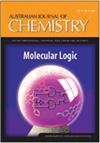取代甲苯中广泛存在扭振相互作用的证据
IF 0.9
4区 化学
Q4 CHEMISTRY, MULTIDISCIPLINARY
引用次数: 0
摘要
扭转常数(F)是从含甲基分子的光谱分析中提取的参数。它的值主要取决于甲基结构。据报道,取代甲苯在基电子态、第一激发单线态或阳离子基电子态下的F值变化很大。通常,这种可变性被认为表明甲基结构与取代基的显著变化,其在环上的位置和电子状态。然而,当大振幅甲基扭转与其他小振幅振动相互作用时,这种解释是误导性的,因为扭转状态转移到较低的能量,导致减少的“有效”F被确定。我们已经观察到甲基扭转与甲苯、对氟甲苯、间氟甲苯和n -甲基吡咯中甲基的低频面外振动之间的耦合,这使我们假设,由于每当甲基附着在平面框架上时都会出现这种运动,因此这种类型的相互作用是普遍存在的。通过将量子化学计算的甲基结构与实验得到的扭转常数进行比较,对一系列取代甲苯进行了验证。量子化学计算预测甲基结构在大范围取代基、环位置和电子态上的变化很小。实验分析中观察到的F值的广泛变化归因于扭转-振动相互作用影响扭转带结构,因此测量的F值成为“有效常数”。计算和实验的扭转常数之间的比较需要认识到这种影响。本文章由计算机程序翻译,如有差异,请以英文原文为准。
Evidence for widespread torsion–vibration interaction in substituted toluenes
The torsional constant (F) is a parameter extracted from spectroscopic analyses of molecules possessing a methyl group. Its value depends primarily on the methyl structure. Widely varying F values have been reported for substituted toluenes in their ground electronic state, first excited singlet electronic state or the ground electronic state of the cation. Conventionally, this variability is assumed to indicate significant changes in the methyl structure with substituent, its position on the ring and the electronic state. However, when the large amplitude methyl torsion interacts with other, small amplitude vibrations, this interpretation is misleading as the torsional states are shifted to lower energy, resulting in a reduced, ‘effective’ F being determined. We have observed coupling between methyl torsion and the low frequency, methyl group out-of-plane wag vibration in toluene, p-fluorotoluene, m-fluorotoluene and N-methylpyrrole, leading us to postulate that, since such motion will be present whenever the methyl group is attached to a planar frame, this type of interaction is widespread. This is tested for a series of substituted toluenes by comparing the methyl group structure calculated by quantum chemistry with the experimental torsional constants. The quantum chemistry calculations predict little variation in the methyl structure across a wide range of substituents, ring positions and electronic state. The wide variation in F values observed in experimental analyses is attributed to the torsion–vibration interaction affecting the torsional band structure, so that measured F values become ‘effective constants’. Comparisons between calculated and experimental torsional constants need to be cognisant of this effect.
求助全文
通过发布文献求助,成功后即可免费获取论文全文。
去求助
来源期刊

Australian Journal of Chemistry
化学-化学综合
CiteScore
2.50
自引率
0.00%
发文量
65
审稿时长
1.3 months
期刊介绍:
Australian Journal of Chemistry - an International Journal for Chemical Science publishes research papers from all fields of chemical science. Papers that are multidisciplinary or address new or emerging areas of chemistry are particularly encouraged. Thus, the scope is dynamic. It includes (but is not limited to) synthesis, structure, new materials, macromolecules and polymers, supramolecular chemistry, analytical and environmental chemistry, natural products, biological and medicinal chemistry, nanotechnology, and surface chemistry.
Australian Journal of Chemistry is published with the endorsement of the Commonwealth Scientific and Industrial Research Organisation (CSIRO) and the Australian Academy of Science.
 求助内容:
求助内容: 应助结果提醒方式:
应助结果提醒方式:


